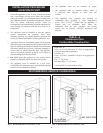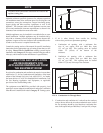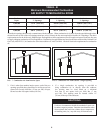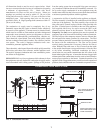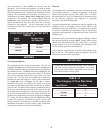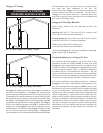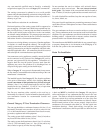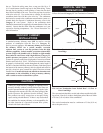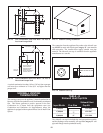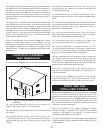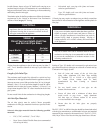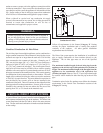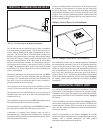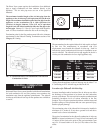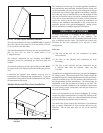
11
the tee. The drain tubing must have a trap provided by a 4"
(10.2 cm)-diameter circular trap loop in the drain tubing. Prime
the trap loop by pouring a small quantity of water into the drain
hose before assembly to the vent. Secure the trap loop in position
with nylon wire ties. Use caution not to collapse or restrict the
condensate drain line with the nylon wire ties. The con den sate
drain must be routed to the con den sate neutralization system or a
suitable drain for disposal of con den sate that may occur in the
Category IV vent system. Refer to the condensate drain
installation instructions as supplied by the manufacturer of the vent
material. Ensure that the drain from the condensate tee is not
exposed to freezing temperatures. See “Freeze Protection” for
more information.
MASONRY CHIMNEY
INSTALLATIONS
A standard masonry chimney must NOT be used to vent the
products of combustion from the flue of a Category IV,
pos i tive pressure appliance. If a masonry chimney is to be used,
the chimney MUST use a sealed, metallic, corrosion
re sis tant liner system to vent flue products from this high
efficiency appliance. Sealed, metallic, corrosion resistant liner
systems (single wall, double-wall, or flexible or rigid metallic
liners) must be rated for use with a high efficiency Category IV,
positive pressure vent system. Corrosion re sis tant chimney liner
systems are typ i cal ly made from a high grade of cor ro sion resistant
stainless steel such as AL 29-4C. The corrosion resistant liner must
be properly sized and fully sealed throughout the entire length if
the flue is contained within the masonry chimney. Both the top and
the bottom of the masonry chimney must be capped and sealed to
provide a dead air space around the sealed corrosion resistant
metallic liner. Consult with local code officials to determine code
re quire ments or the advisability of using a masonry chimney
with a sealed cor ro sion resistant liner system.
CAUTIONƽ
Venting of a high efficiency Category IV appliance into a
masonry chimney without a sealed stainless steel liner can
result in operational and safety problems. Any breaks, leaks
or damage to the masonry flue/tile will allow spillage of the
positive pressure flue products from the chimney. These
flue products can easily escape into an occupied living
space causing a health hazard. If there is any doubt about
the condition of a masonry chimney, or its acceptability for
use after inser tion of a corrosion resistant liner system,
consult with local code officials.
VERTICAL VENTING
TERMINATIONS
Follow all General Category IV Vent Termination Clearances.
RIDGE
CHIMNEY
3' MIN
2' MIN
10' OR LESS
FIG. 13 Vent Termination from Peaked Roof - 10 Feet or Less
from Ridge
RIDGE
CHIMNEY
3' MIN
2' MIN
MORE THAN 10'
10'
FIG. 14 Vent Termination from Peaked Roof - 10 Feet or
More from Ridge
The vent terminal should be vertical and exhaust outside the build-
ing at least 2 feet (0.61 m) above the highest point of the roof within
a 10 foot (3.05 m) radius of the termination.
The vertical termination must be a minimum of 3 feet (0.91 m)
above the point of exit.




